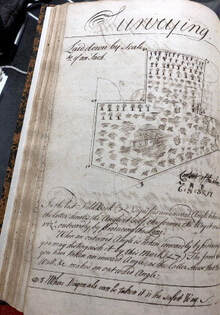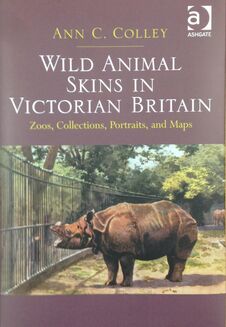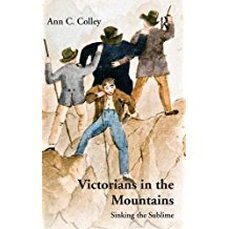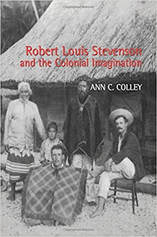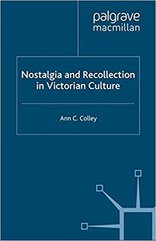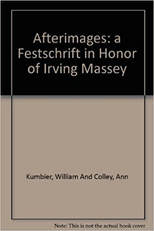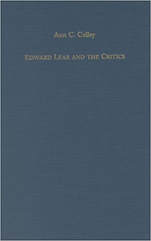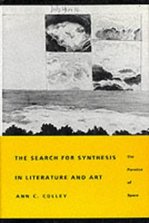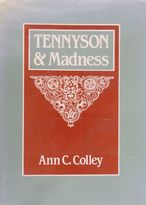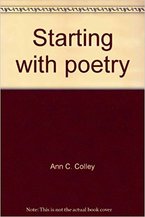Coleridge and the Geometric Idiom — Walking with Euclid
|
In 2023, Cambridge University Press published Coleridge and the Geometric Idiom - Walking with Euclid by Ann Colley. In the book, Colley outlines Coleridge’s alertness to the geometric idiom that helped shaped his responses to the landscape of his surroundings. In particular, Colley explains why Euclid’s Elements was such a basic text in Coleridge’s cultural context. To guide the reader, the introduction outlines the book’s argument, and, the chapter summaries provide an overview of the author's research for the book, conducted while in residence at Cambridge. Learn more about the book, here.
|
|
Romanticism, Volume 27.1 (2021): 28-45. Romantic Walking
|
The journal, Romanticism, offers a forum for the best critical and scholarly work in Romantic studies today. The journal focuses on the literary period of 1750-1850, publishing research on critical, historical, textual and bibliographical aspects, representing a full range of current methodological and theoretical debates. Volume 27.1 of the journal features work by Ann C. Colley: “Coleridge Walks: Boots and the Measure of the Landscape.” Romantic Walking. Romanticism is published by the Edinburgh University Press. Romanticism 27.1 (2021), 28-45 Read the work, here.
|
|
Wild Animal Skins in Victorian Britain
Aldershot, England. Ashgate (now Routledge) Publishing. Ltd. 2014. What did the 13th Earl of Derby, his twenty-two-year-old niece, Manchester’s Belle Vue Zoo, and even some ordinary laborer all have in common? All were avid collectors and exhibitors of exotic, and frequently unruly, specimens. In her study of Britain’s craze for natural history collecting, Colley makes extensive use of archival materials to examine the challenges, preoccupations, and disordered circumstances that attended the amassing of specimens from faraway places only vaguely known to the British public. As scientific institutions sent collectors to bring back exotic animals and birds for study and classification by anatomist and zoologists, it soon became apparent that collecting skins rather than live animals or birds was a relatively more manageable endeavor. Colley looks at the collecting, exhibiting, and portraying animal skins to show their importance as trophies of empire and representations of identity. While a zoo might display skins to promote and glorify Britain’s colonial achievements, Colley suggests that the reality of collecting was characterized more by curiosity and chaos than imperial order. For example, Edward Lear’s commissioned illustrations of the Earl of Derby’s extensive collection challenge the colonial’s or collector’s commanding gaze, while the Victorian public demonstrated a yearning to connect with their own wildness by touching the skins of animals. Colley concludes with a discussion of the metaphorical uses of wild skins by Gerard Manley Hopkins and other writers, exploring the idea of skin as a locus of memory and touch were one’s past can be traced in the same way that nineteenth-century mapmakers charted a landscape. Throughout the book Colley calls upon recent theories about the nature and function of skin and touch to structure her discussion of the Victorian fascination with wild animal skins. |
|
Victorians in the Mountains: Sinking the Sublime.
Aldershot, England. Ashgate Publishing Limited. December, 2010. In Part One, Colley mines diaries and letters to interrogate how everyday tourists and climbers both responded to and undercut ideas about the sublime, showing how technological advances like the telescope transformed mountains into theatrical spaces where tourists thrilled to the sight of struggling climbers; almost inevitably, these distant performances were eventually reenacted at exhibitions and on the London stage. Colley’s examination of the Alpine Club archives, periodicals, and other primary resources offers a more complicated and inclusive picture of female mountaineering as she documents the strong presence of women on successful expeditions in the latter half of the century. In Part Two, Colley turns to John Ruskin, Gerard Manley Hopkins, and Robert Louis Stevenson, whose writings about the Alps reflect their feelings about their Romantic heritage and shed light on their ideas about perception, metaphor, and literary style. Colley concludes by offering insights into the ways in which expeditions to the Himalayas affected people’s sense of the sublime, arguing that these individuals were motivated as much by the glory of Empire as by aesthetic sensibility. Her book is an astute exploration of nationalism, as well as theories of gender, spectacle, and the technicalities of glacial movement that were intruding on what before had seemed inviolable. |
|
Robert Louis Stevenson and the Colonial Imagination.
Aldershot, England: Ashgate Publishing Limited. 2004. In her distinguished and hauntingly rendered book, Ann C. Colley provides a fresh insight into Stevenson's multi-voiced South Seas fiction, as well as into the particulars and complications of living within a newly established site of Empire. Bringing to light information from the archives of the London Missionary Society and from other sources, such as the Royal Geographical Society (London), the Writers' Museum (Edinburgh), the Beinecke Library (Yale University), and the Huntington Library (San Marino, California), Colley examines the intricate nature of Robert Louis Stevenson's relation to imperialism. In particular, she investigates Stevenson's complex relationship to the missionary culture that surrounded him during the last six years of his life (1888-1894), revealing hitherto unscouted routes by which to understand Stevenson's experiences while he was cruising among the South Sea islands, and later while he was a resident colonial in Samoa. Beginning with a history of the missionaries in the Pacific that reveals Stevenson's criticism of, yet ultimate support for, their work, and demonstrates how these attitudes helped shape his South Sea fiction, Robert Louis Stevenson and the Colonial Imagination constitutes a major work of reconstruction from archival sources. Subsequent chapters focus on Stevenson's struggles with personal and cultural identity in the South Seas, and his interest in photography, panoramas, and magic lantern shows, revealing Stevenson's sensitivity to the ways light plays upon darkness to create meaning. In addition, Stevenson's serious commitment to political issues and his thoughts about power and nationhood are explored. Finally, Stevenson's recollections of his childhood are engaged not only to suggest an unacknowledged source (the juvenile missionary magazines) for A Child's Garden of Verses, but also to illuminate the generous reach of his imagination that exceeds the formulae of the missionary culture and the boundaries of the colonial construct. |
|
Nostalgia and Recollection in Victorian Culture.
Basingstoke, England: Macmillan Press. Published by St. Martin's Press in the United States. 1998. This book is about a group of Victorian British writers and artists whose work emerges from recollection and whose texts embody the experience of nostalgia. In it discussion of Charles Darwin’s The Voyage of the Beagle, Robert Louis Stevenson’s prose and poetry, Elizabeth Gaskell’s narratives, John Ruskin’s Praeterita, Walter Pater’s “The Child in the House,” Ford Madox Brown’s The Last of England, Richard Redgrave’s The Emigrants’ Last Sight of Home, and a series of J. M. W. Turner’s engravings, this study concentrates on the longing for a past that traverses the span of these writers’ and artists’ own lives. It examines their particular experience of the nostalgic moment; it also provides an occasion to re-examine the idea of nostalgia itself and to reflect on the act of recollection that accompanies it. |
|
Afterimages: a Festschrift in Honor of Irving Massey.
William Kumbier and Ann C. Colley. Shuffaloff, 1996. Available on Amazon. |
|
Edward Lear and the Critics. (Literary Criticism in Perspective)
Camden House, Inc. 1993. This book is a history of how criticism from the nineteenth century on has regarded Lear’s extensive work. |
|
The Search for Synthesis in Literature and Art:
The Paradox of Space. The University of Georgia Press. 1990. In The Search for Synthesis in Literature and Art, Colley breaks new ground using metaphor to rethink the relation between verbal and visual images and, in a broader sense, to examine the desire for personal fusion in friendship and love. Drawing upon a wide range of artistic and literature figures, Colley emphasizes the paradox that synthesis is possible only when space remains between the elements that seek to blend. Contrary to what is often thought, she writes “the power of metaphor does not necessarily depend on its faculty to fuse the dissimilar. The figure’s potency also dwells within its structural gaps … The promise of synthesis is, paradoxically, available within those gaps.” To reveal the intrinsic structure of metaphor, Colley turns first to the nonsense verse of Edward Lear. Lear’s limericks and drawings, in their tendency to link incongruous objects (carp/harp, hatchet/flea), remind the reader of the ever-present audible and visible space within metaphor. By contrast, the metamorphoses described in Ovid and Dante illustrate the deadly sterility of transformation that lacks the saving space of metaphor – a merging of words and images in which one form of expression entraps or misrepresents the other. Colley goes on to show how the dialogue between words and pictures becomes a shaping force in the work of Paul Klee; he fuses the two but also honors and sustains their difference. |
|
Tennyson & Madness.
The University of Georgia Press. 1983. The book describes Tennyson’s encounters with mental illness and examines the treatment of the theme of madness in his poetry. |
|
Starting with Poetry.
_________ with Judith K. Moore. Harcourt, Brace, Jovanovich. 1973. Available on Amazon. |
BOOK CHAPTERS
“Collecting the Live and the Skinned.” Animals in Victorian Literature and Culture. Ed.
Laurence W. Mazzeno and Ronald D. Morrison. London: Palgrave, 2017. 21-40.
“Twaddle and Lies: Letters in Stevenson’s Later Fiction.” Robert Louis Stevenson. Ed.
Richard J. Hill. London: Routledge, 2017.
“Exposure and Image: A Visual Approach.” Approaches to Teaching the Works of Robert
Louis Stevenson. Ed. Caroline McCracken-Flesher. New York: Modern Language
Association, 2013. 141-46.
“Hybridity and Stevenson’s South Seas Fiction” included in a collection of essays on
hybridity. Johns Hopkins University Press. 2010.
“The Ordeal of Landscape” in Proceedings of the 2008 Biennual Robert
Louis Stevenson International Conference held in Bergamo, Italy.
“An Elegy for Nancy Burke” in Essays Honoring Nancy Burke. University of Warsaw
Press, 2006. (15 pages).
“Bodies and Mirrors” in Interior Design Theory Reader. Eds. Mark Taylor and Julieanna
Preston. West Sussex, England: John Wiley & Sons, Ltd. May, 2006.
“Conrad, Stevenson and Cannibalism” in Stevenson and Conrad: Writers of Land and
Sea. Eds. Linda Dryden, Stephen Arata, & Eric Massie. Texas Tech. University
Press. (2009) (25 pages).
“Explorations in American Poetics: Beyond the Boundaries of the Printed Page” in The Poetics of America:
Explorations in the Literature and Culture of the United States. Ed. Agata Preis-Smith and Marek Paryz.
Warsaw: University of Warsaw Press, 2004. 133-50.
“The Landscape of Robert Louis Stevenson's A Child's Garden of Verses” in Robert Louis Stevenson Reconsidered:
Essays in honor of David Daiches. Ed. William Bryan Jones. Wisconsin: McFarland Company, 2003.
“Bodies and Mirrors: The Childhood Interiors of Ruskin, Pater, and Stevenson” in Domestic Space: Reading the Nineteenth-Century Interior. Eds. I. Bryden and J. Floyd. Manchester: Manchester University Press. 1999.
CHAPTERS IN REFERENCE BOOKS
“Robert Louis Stevenson.” The Encyclopedia of Victorian Literature. Ed. Dino Franco
Felluga. Wiley Blackwell, 2015.
“Writing Towards Home: The Landscape of A Child’s Garden of Verses” Children’s
Literature Review. Gale Press, 2005 and 2008.
“Edward Lear’s Anti-Colonial Bestiary” in Poetry Criticism. Gale Press. August, 2005. (11 pages).
“The Quest for the ‘Nameless’ in Tennyson's ‘The Lady of Shalott’.” Poetry for Students.
The Gale Group and GaleNet. Spring, 2002.
“The Limerick and the Space of Metaphor” in Poetry Criticism. Gale Press, August, 2005.
(37 pages).
“Edward Lear's Limericks and the Reversals of Nonsense.” Children's Literature Review.
The Gale Group. Vol. 75. Winter, 2001 and reprinted in 2006.
“Edward Lear's Nonsense” in Humour in Eighteenth- and Nineteenth-Century British Literature: A Reference Guide.
Ed. Don L. F. Nilsen. Westport, CT: Greenwood Press. 1998. 204-06.
“Tennyson's The Idylls of the King” in Nineteenth-Century Literary Criticism. Vol. 30.
Eds. Laurie DiMauro and Paula Kepou. London: Gale Research Inc. 287-93.
Laurence W. Mazzeno and Ronald D. Morrison. London: Palgrave, 2017. 21-40.
“Twaddle and Lies: Letters in Stevenson’s Later Fiction.” Robert Louis Stevenson. Ed.
Richard J. Hill. London: Routledge, 2017.
“Exposure and Image: A Visual Approach.” Approaches to Teaching the Works of Robert
Louis Stevenson. Ed. Caroline McCracken-Flesher. New York: Modern Language
Association, 2013. 141-46.
“Hybridity and Stevenson’s South Seas Fiction” included in a collection of essays on
hybridity. Johns Hopkins University Press. 2010.
“The Ordeal of Landscape” in Proceedings of the 2008 Biennual Robert
Louis Stevenson International Conference held in Bergamo, Italy.
“An Elegy for Nancy Burke” in Essays Honoring Nancy Burke. University of Warsaw
Press, 2006. (15 pages).
“Bodies and Mirrors” in Interior Design Theory Reader. Eds. Mark Taylor and Julieanna
Preston. West Sussex, England: John Wiley & Sons, Ltd. May, 2006.
“Conrad, Stevenson and Cannibalism” in Stevenson and Conrad: Writers of Land and
Sea. Eds. Linda Dryden, Stephen Arata, & Eric Massie. Texas Tech. University
Press. (2009) (25 pages).
“Explorations in American Poetics: Beyond the Boundaries of the Printed Page” in The Poetics of America:
Explorations in the Literature and Culture of the United States. Ed. Agata Preis-Smith and Marek Paryz.
Warsaw: University of Warsaw Press, 2004. 133-50.
“The Landscape of Robert Louis Stevenson's A Child's Garden of Verses” in Robert Louis Stevenson Reconsidered:
Essays in honor of David Daiches. Ed. William Bryan Jones. Wisconsin: McFarland Company, 2003.
“Bodies and Mirrors: The Childhood Interiors of Ruskin, Pater, and Stevenson” in Domestic Space: Reading the Nineteenth-Century Interior. Eds. I. Bryden and J. Floyd. Manchester: Manchester University Press. 1999.
CHAPTERS IN REFERENCE BOOKS
“Robert Louis Stevenson.” The Encyclopedia of Victorian Literature. Ed. Dino Franco
Felluga. Wiley Blackwell, 2015.
“Writing Towards Home: The Landscape of A Child’s Garden of Verses” Children’s
Literature Review. Gale Press, 2005 and 2008.
“Edward Lear’s Anti-Colonial Bestiary” in Poetry Criticism. Gale Press. August, 2005. (11 pages).
“The Quest for the ‘Nameless’ in Tennyson's ‘The Lady of Shalott’.” Poetry for Students.
The Gale Group and GaleNet. Spring, 2002.
“The Limerick and the Space of Metaphor” in Poetry Criticism. Gale Press, August, 2005.
(37 pages).
“Edward Lear's Limericks and the Reversals of Nonsense.” Children's Literature Review.
The Gale Group. Vol. 75. Winter, 2001 and reprinted in 2006.
“Edward Lear's Nonsense” in Humour in Eighteenth- and Nineteenth-Century British Literature: A Reference Guide.
Ed. Don L. F. Nilsen. Westport, CT: Greenwood Press. 1998. 204-06.
“Tennyson's The Idylls of the King” in Nineteenth-Century Literary Criticism. Vol. 30.
Eds. Laurie DiMauro and Paula Kepou. London: Gale Research Inc. 287-93.
ARTICLES
“The Morbid and the Trendy.” Victorian Literature and Culture. 46:1 2018.
“Conversations with Oscar Wilde.” Victorian Literature and Culture. (Cambridge UP) V.
14, 2015, 188-195.
“Portrait, Empire, and Industry at the Belle Vue Zoo, Manchester” Victorian
Literature and Culture (Cambridge University Press), 2013. 39 pages.
“Edward Lear and Victorian Animal Portraiture” Rivista di Studi Vittorianni. XVII-XVIII:
34-35 (2013): 11-26.
“Locating Home.” Journal of Stevenson Studies. 2011.
Invited to publish an article for a special issue of Victorian Review
dedicated to Victorian-Eco Systems. 2010.
Studies in English Literature (The Johns Hopkins University Press) commissioned
Dr. Colley to write the Year’s Review of Nineteenth-Century Studies (a review of 250
books) for 2007-2008. The article appeared as “Recent Studies in the Nineteenth
Century.” Studies in English Literature. 48:4 (autumn 2008). 935-1010.
“Recent Studies in the Nineteenth Century.” Studies in English Literature. 48:4 (Autumn
2008): 935-1010.
“John Ruskin: Climbing and the Vulnerable Eye.” Victorian Literature and Culture.
Cambridge University Press. (2009) 37: 43-65.
”Robert Louis Stevenson’s South Seas Crossings.” Studies in English Literature 48:4
(autumn 2008): 871-884.
“Journeying out of the Comfort Zone.” Rivista di Studi Vittoriani (Italy).Vol. 20, July, 2005.
167-189.
“Colonies of Memory.” Victorian Literature and Culture. Cambridge University Press.
Volume 31, No. 2, 2003. 405-427.
“Stevenson's Pyjamas.” Victorian Literature and Culture. Cambridge University Press.
30:1 (2002) 129-155.
“The Experience of Captivity in American Captivity and Slave Narratives.” [title in
Russian]. 3: 2 (December 2000): 210-217.
“Memory and Chinese Boxes.” Haykoba [title in Ukrainian]. Kiev, February, 2000. 140-
144.
“Reflections on the Teaching of American Literature.” Trans. into Ukrainian by Tamara
Denisova.Word and Time (Fulbright Journal, Ukraine). No. 9, 2000. 58-61.
“The American Slave Narrative as Literary Form.” [title in Ukrainian]. Odessa, 2000. 140-
142.
“Ruskin and Turner's ‘arrangements of remembrance’.” The Ruskin Gazette of the Ruskin
Society of London. 1: 10 (1997): 38-54.
“Writing Towards Home: The Landscape of Robert Louis Stevenson's A Child's Garden
of Verses.” Victorian Poetry. 35: 3 (Fall 1997): 303-318.
“Robert Louis Stevenson and the Idea of Recollection.” Victorian Literature and Culture.
25: 2 (1997): 203-224.
“Kate Chopin's The Awakening as Displaced Conversion Narrative.” Anglica (University of
Warsaw). Vol. 8. (January, 1996): 9-18.
“A Tennyson Letter in St. Petersburg.” The Tennyson Research Bulletin. Vol. 6.
(November, 1994): 202-06.
“Edward Lear's Anti-Colonial Bestiary.” Victorian Poetry. Vol. 30 (summer 1992): 109-
120.
“Mapping In and Out of the Boundaries of Time: Ruskin and Hopkins.” Victorian
Literature and Culture. Vol. 19 (1991): 107-121.
“From the Photograph to the Essay: Writing as Translation.” Writing on the Edge.
Vol. 3 (fall 1991): 50-60. University of California, Davis.
“Emily Tennyson's Deathbed.” Tennyson Research Bulletin. (Fall, 1991).
“Nostalgia in the Voyage of the H.M.S. Beagle.” The Centennial Review. Vol. 25.
(Winter 1991):167-184.
“Issues on the Teaching of Writing.” SUNY Council on Writing Proceedings. 1990.
“The Limerick and the Space of Metaphor.” Genre. 21:1 (Spring 1988): 65-93.
“Edward Lear's Limericks and the Inversions of Nonsense.” Victorian Poetry. 26: 3.
(Autumn 1988): 285-300.
“Revision and Otherness.” The English Record. 39: 3. (1988): 2-9.
“G. M. Hopkins and the Idea of Mapping.” Word & Image. April-June, 1988. 523-528.
“Paul Klee and the Fantasy of Synthesis.” The Kenyon Review. Summer, 1987. 1-15.
“A Defense of the ‘I’.” CEA Forum. Vol. 17. (1987-88): 10-13.
“Edward Lear and the Pre-Raphaelite Impossibility.” The Journal of Pre-Raphaelite
Studies. 7:1. (November, 1986): 5-7.
“The Risk of Chaos: A Revision for the Teaching of Writing.” The English Record.
37: 1 (1986): 5-7.
“The Quest for the ‘Nameless’ in Tennyson's ‘The Lady of Shalott’.” Victorian Poetry.
23:4. (Winter 1985): 369-378.
“Edward Lear and Thomas Seddon: The Paradox of Inquiry.” The Journal of Pre-
Raphaelite Studies. 5:1. (November 1984): 36-48.
“Alfred Tennyson's ‘Four Crisises [sic]’” Another View of the Water Cure." The
Tennyson Research Bulletin. 3: 2. (November 1979): 64-68.
“The Conflict Between Tradition and Modern Values in Tennyson's The Princess.”
The Bucknell Review. (Spring 1978): 37-48.
“Don L. Lee's ‘But He Was Cool or He Even Stopped for Green Lights’: An Example of
the New Black Aesthetic.” Concerning Poetry. 4: 2. 20-28.
“Conversations with Oscar Wilde.” Victorian Literature and Culture. (Cambridge UP) V.
14, 2015, 188-195.
“Portrait, Empire, and Industry at the Belle Vue Zoo, Manchester” Victorian
Literature and Culture (Cambridge University Press), 2013. 39 pages.
“Edward Lear and Victorian Animal Portraiture” Rivista di Studi Vittorianni. XVII-XVIII:
34-35 (2013): 11-26.
“Locating Home.” Journal of Stevenson Studies. 2011.
Invited to publish an article for a special issue of Victorian Review
dedicated to Victorian-Eco Systems. 2010.
Studies in English Literature (The Johns Hopkins University Press) commissioned
Dr. Colley to write the Year’s Review of Nineteenth-Century Studies (a review of 250
books) for 2007-2008. The article appeared as “Recent Studies in the Nineteenth
Century.” Studies in English Literature. 48:4 (autumn 2008). 935-1010.
“Recent Studies in the Nineteenth Century.” Studies in English Literature. 48:4 (Autumn
2008): 935-1010.
“John Ruskin: Climbing and the Vulnerable Eye.” Victorian Literature and Culture.
Cambridge University Press. (2009) 37: 43-65.
”Robert Louis Stevenson’s South Seas Crossings.” Studies in English Literature 48:4
(autumn 2008): 871-884.
“Journeying out of the Comfort Zone.” Rivista di Studi Vittoriani (Italy).Vol. 20, July, 2005.
167-189.
“Colonies of Memory.” Victorian Literature and Culture. Cambridge University Press.
Volume 31, No. 2, 2003. 405-427.
“Stevenson's Pyjamas.” Victorian Literature and Culture. Cambridge University Press.
30:1 (2002) 129-155.
“The Experience of Captivity in American Captivity and Slave Narratives.” [title in
Russian]. 3: 2 (December 2000): 210-217.
“Memory and Chinese Boxes.” Haykoba [title in Ukrainian]. Kiev, February, 2000. 140-
144.
“Reflections on the Teaching of American Literature.” Trans. into Ukrainian by Tamara
Denisova.Word and Time (Fulbright Journal, Ukraine). No. 9, 2000. 58-61.
“The American Slave Narrative as Literary Form.” [title in Ukrainian]. Odessa, 2000. 140-
142.
“Ruskin and Turner's ‘arrangements of remembrance’.” The Ruskin Gazette of the Ruskin
Society of London. 1: 10 (1997): 38-54.
“Writing Towards Home: The Landscape of Robert Louis Stevenson's A Child's Garden
of Verses.” Victorian Poetry. 35: 3 (Fall 1997): 303-318.
“Robert Louis Stevenson and the Idea of Recollection.” Victorian Literature and Culture.
25: 2 (1997): 203-224.
“Kate Chopin's The Awakening as Displaced Conversion Narrative.” Anglica (University of
Warsaw). Vol. 8. (January, 1996): 9-18.
“A Tennyson Letter in St. Petersburg.” The Tennyson Research Bulletin. Vol. 6.
(November, 1994): 202-06.
“Edward Lear's Anti-Colonial Bestiary.” Victorian Poetry. Vol. 30 (summer 1992): 109-
120.
“Mapping In and Out of the Boundaries of Time: Ruskin and Hopkins.” Victorian
Literature and Culture. Vol. 19 (1991): 107-121.
“From the Photograph to the Essay: Writing as Translation.” Writing on the Edge.
Vol. 3 (fall 1991): 50-60. University of California, Davis.
“Emily Tennyson's Deathbed.” Tennyson Research Bulletin. (Fall, 1991).
“Nostalgia in the Voyage of the H.M.S. Beagle.” The Centennial Review. Vol. 25.
(Winter 1991):167-184.
“Issues on the Teaching of Writing.” SUNY Council on Writing Proceedings. 1990.
“The Limerick and the Space of Metaphor.” Genre. 21:1 (Spring 1988): 65-93.
“Edward Lear's Limericks and the Inversions of Nonsense.” Victorian Poetry. 26: 3.
(Autumn 1988): 285-300.
“Revision and Otherness.” The English Record. 39: 3. (1988): 2-9.
“G. M. Hopkins and the Idea of Mapping.” Word & Image. April-June, 1988. 523-528.
“Paul Klee and the Fantasy of Synthesis.” The Kenyon Review. Summer, 1987. 1-15.
“A Defense of the ‘I’.” CEA Forum. Vol. 17. (1987-88): 10-13.
“Edward Lear and the Pre-Raphaelite Impossibility.” The Journal of Pre-Raphaelite
Studies. 7:1. (November, 1986): 5-7.
“The Risk of Chaos: A Revision for the Teaching of Writing.” The English Record.
37: 1 (1986): 5-7.
“The Quest for the ‘Nameless’ in Tennyson's ‘The Lady of Shalott’.” Victorian Poetry.
23:4. (Winter 1985): 369-378.
“Edward Lear and Thomas Seddon: The Paradox of Inquiry.” The Journal of Pre-
Raphaelite Studies. 5:1. (November 1984): 36-48.
“Alfred Tennyson's ‘Four Crisises [sic]’” Another View of the Water Cure." The
Tennyson Research Bulletin. 3: 2. (November 1979): 64-68.
“The Conflict Between Tradition and Modern Values in Tennyson's The Princess.”
The Bucknell Review. (Spring 1978): 37-48.
“Don L. Lee's ‘But He Was Cool or He Even Stopped for Green Lights’: An Example of
the New Black Aesthetic.” Concerning Poetry. 4: 2. 20-28.
Copyright © 2023

